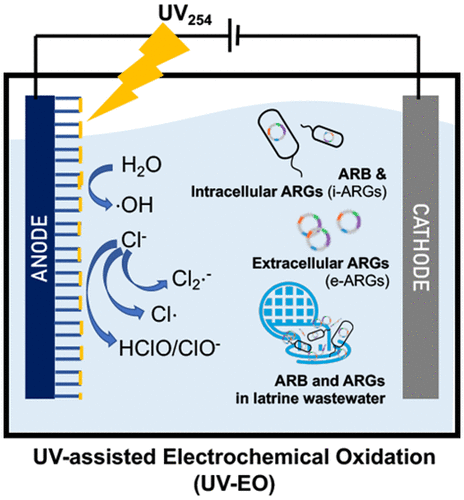当前位置:
X-MOL 学术
›
ACS ES&T Eng.
›
论文详情
Our official English website, www.x-mol.net, welcomes your
feedback! (Note: you will need to create a separate account there.)
Removal of Antibiotic Resistant Bacteria and Genes by UV-Assisted Electrochemical Oxidation on Degenerative TiO2 Nanotube Arrays
ACS ES&T Engineering ( IF 7.4 ) Pub Date : 2021-03-02 , DOI: 10.1021/acsestengg.1c00011 Siwen Wang 1, 2 , Shasha Yang 2 , Estefanny Quispe 2 , Hannah Yang 3 , Charles Sanfiorenzo 3 , Shane W. Rogers 2 , Kaihang Wang 3 , Yang Yang 2 , Michael R. Hoffmann 1
ACS ES&T Engineering ( IF 7.4 ) Pub Date : 2021-03-02 , DOI: 10.1021/acsestengg.1c00011 Siwen Wang 1, 2 , Shasha Yang 2 , Estefanny Quispe 2 , Hannah Yang 3 , Charles Sanfiorenzo 3 , Shane W. Rogers 2 , Kaihang Wang 3 , Yang Yang 2 , Michael R. Hoffmann 1
Affiliation

|
Antibiotic resistance has become a global crisis in recent years, while wastewater treatment plants (WWTPs) have been identified as a significant source of both antibiotic resistant bacteria (ARB) and antibiotic resistance genes (ARGs). However, commonly used disinfectants have been shown to be ineffective for the elimination of ARGs. With the goal of upgrading the conventional UV disinfection unit with stronger capability to combat ARB and ARGs, we developed a UV-assisted electrochemical oxidation (UV-EO) process that employs blue TiO2 nanotube arrays (BNTAs) as photoanodes. Inactivation of tetracycline- and sulfamethoxazole-resistant E. coli along with degradation of the corresponding plasmid coded genes (tetA and sul1) is measured by plate counting on selective agar and qPCR, respectively. In comparison with UV254 irradiation alone, enhanced ARB inactivation and ARG degradation is achieved by UV-EO. Chloride significantly promotes the inactivation efficiency due to the electrochemical production of free chlorine and the subsequent UV/chlorine photoreactions. The fluence-based first-order kinetic rate coefficients of UV-EO in Cl– are larger than those of UV254 irradiation alone by a factor of 2.1–2.3 and 1.3–1.8 for the long and short target genes, respectively. The mechanism of plasmid DNA damage by different radical species is further explored using gel electrophoresis and computational kinetic modeling. The process can effectively eliminate ARB and ARGs in latrine wastewater, though the kinetics were retarded.
中文翻译:

变性TiO 2纳米管阵列上紫外线辅助电化学氧化去除抗生素抗性细菌和基因
近年来,抗生素耐药性已成为全球性危机,而废水处理厂(WWTP)已被确定为抗生素耐药菌(ARB)和抗生素耐药基因(ARG)的重要来源。但是,已显示常用的消毒剂对消除ARG无效。为了升级常规紫外线消毒装置,使其具有更强的抗ARB和ARG的能力,我们开发了一种紫外线辅助电化学氧化(UV-EO)工艺,该工艺采用蓝色TiO 2纳米管阵列(BNTAs)作为光阳极。灭活耐四环素和磺胺甲恶唑的大肠杆菌以及相应质粒编码基因(tetA和sul1的降解)通过分别在选择性琼脂和qPCR上的平板计数来测量)。与单独的UV 254辐射相比,UV-EO可以增强ARB的灭活和ARG的降解。由于游离氯的电化学产生和随后的UV /氯光反应,氯化物显着提高了灭活效率。Cl –中UV-EO的基于注量的一级动力学速率系数大于UV 254的基于通量的一级动力学速率系数对于长和短靶基因,单独照射的辐射系数分别为2.1–2.3和1.3–1.8。使用凝胶电泳和计算动力学模型,进一步探索了质粒DNA受到不同自由基种类破坏的机理。该过程可以有效地消除厕所废水中的ARB和ARGs,尽管其动力学受到了阻碍。
更新日期:2021-03-12
中文翻译:

变性TiO 2纳米管阵列上紫外线辅助电化学氧化去除抗生素抗性细菌和基因
近年来,抗生素耐药性已成为全球性危机,而废水处理厂(WWTP)已被确定为抗生素耐药菌(ARB)和抗生素耐药基因(ARG)的重要来源。但是,已显示常用的消毒剂对消除ARG无效。为了升级常规紫外线消毒装置,使其具有更强的抗ARB和ARG的能力,我们开发了一种紫外线辅助电化学氧化(UV-EO)工艺,该工艺采用蓝色TiO 2纳米管阵列(BNTAs)作为光阳极。灭活耐四环素和磺胺甲恶唑的大肠杆菌以及相应质粒编码基因(tetA和sul1的降解)通过分别在选择性琼脂和qPCR上的平板计数来测量)。与单独的UV 254辐射相比,UV-EO可以增强ARB的灭活和ARG的降解。由于游离氯的电化学产生和随后的UV /氯光反应,氯化物显着提高了灭活效率。Cl –中UV-EO的基于注量的一级动力学速率系数大于UV 254的基于通量的一级动力学速率系数对于长和短靶基因,单独照射的辐射系数分别为2.1–2.3和1.3–1.8。使用凝胶电泳和计算动力学模型,进一步探索了质粒DNA受到不同自由基种类破坏的机理。该过程可以有效地消除厕所废水中的ARB和ARGs,尽管其动力学受到了阻碍。











































 京公网安备 11010802027423号
京公网安备 11010802027423号